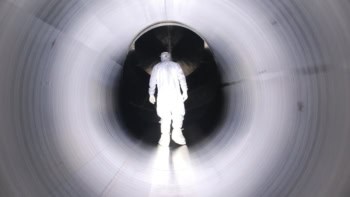
An important missing piece of the Standard Model of particle physics has been discovered by researchers at Fermilab in the US, home to the world’s most powerful operational particle collider, the Tevatron. On Wednesday the CDF and D0 experiments independently reported unambiguous evidence that top quarks, the heaviest of the six known quark flavours, can be produced individually rather than in pairs as had been observed until now (arXiv 0903.0885v1 and arXiv 0903.0850v1 both submitted to Phys. Rev. Lett.).
Because singly produced top quarks decay into final states that mimic the signature expected for the Standard Model Higgs boson — the biggest missing chunk of the 35-year-old theory — the results bode well for the Higgs search currently gathering pace at the Tevatron while CERN’s more powerful Large Hadron Collider (LHC) is being repaired. “We would not be able to claim evidence for a low-mass Higgs if we did not first observe single top quark production,” says D0 co-spokesperson Darien Wood.
No fourth generation
The top quark was discovered by CDF and D0 in 1995, completing the “three generation” structure of the Standard Model in which the up and down quarks that make up ordinary nuclear matter (with electrical charges of +2/3 and -1/3, respectively) have heavier copies: charm and strange, top and bottom. The same mysterious hierarchy exists for leptons, the lightest generation comprising the electron and the electron neutrino.
We would not be able to claim evidence for a low-mass Higgs if we did not first observe single top quark production
Darien Wood, D0 co-spokesperson
In the discovery of the top quark and subsequent measurements of its properties, the particle (weighing 180 times more than the proton) was produced in pairs along with its antimatter partner — a process that only involves the strong nuclear force. But the Standard Model predicts that tops are also produced singly via the electroweak force, for example when a proton–antiproton collision produces an excited W boson that decays into a top and a bottom quark.
While the process is rarer than pair-produced tops and mired in similar-looking background events, the rate at which single tops are produced gives a direct measurement of V_tb — one of the elements in the 3×3 Cabibbo–Kobayashi–Maskawa “mixing” matrix, which describes how quarks transform into different flavours via the weak force. Having now measured the cross section for single-top production and shown that V_tb is closer to one than to zero, the Fermilab results strongly disfavour the existence of a fourth generation of quarks.
Healthy competition
Paul de Jong, who works on the LHC’s ATLAS experiment, describes the Fermilab results as a tour de force, requiring sophisticated analysis techniques that potentially will lead to an earlier observation of the Higgs. “At the LHC we will collect a significantly larger sample of single top quarks,” he adds, “but we can only congratulate D0 and CDF for this fine piece of work.”
We can only congratulate D0 and CDF for this fine piece of work.
Paul de Jong, member of the ATLAS experiment at the LHC
Although CDF and D0 first reported evidence for single-top production in 2007, in the past 18 months the experiments have doubled the number of proton–antiproton collisions recorded. The extra data have allowed each collaboration to achieve — based on rather different analysis techniques and with CDF using 40% more events than D0 — a statistical significance of over five standard deviations.
The CDF and D0 preprints were posted just hours apart, yet both claim first observation of single top production. “There is a constructive rivalry that improves both experiments,” says CDF member Mark Lancaster of University College London. “We happily combine our results for the Higgs searches.”
New Higgs limits based on the latest Tevatron data are expected to be presented in the coming months, potentially excluding larger regions of the Higgs mass range than the 170 GeV already excluded by Fermilab last year.



